Topic 1: Cell biology 
This page contains multiple choice questions in the style of Paper 1 of the Biology exams.
They test the breadth of your knowledge of the understandings and skills about cell biology.
To spend more time reviewing the topic before answering these questions, use the revision resources.
Cell biology revision resources
This page lists the understandings and skills expected for Topic 1 and links to the sub-topic pages which contain detailed revision notes, activities and past paper style questions. Great for revision.
Learn from any mistakes. Every question has an examiner's explanation that appears when you check your answers.
Spontaneous generation was a popular concept a few hundred years ago.
Which of the following statements best summarises the theory?
The theory of spontaneous generation tried to explain the occurance of organisms like maggots, mould and bacteria in rotting food. Pasteur's experiments falsified this theory.
What is the best definition of endosymbiosis?
Endosymbiosis is where a cell engulfs another cell and it continues to live inside the cell.
The engulfed cell provides something for the host cell, and gets something in return. Both cells benefit.
The microscope image shows cells in a tissue sample taken from a growth suspected of being cancerous.
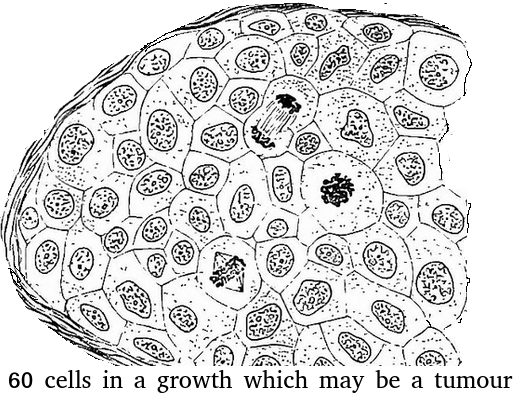
What is the best estimate of the mitotic index of this tissue?
Assume that there are exactly 60 cells (for simplicity).
Skill: Determination of a mitotic index from a micrograph
There are 3 cells in stages of mitosis.
So the mitotic index = 3 divided by 60 cells total.
Keeping it simple = 1 / 20 or 0.05
Sodium channels are made from a protein.
Where in the cell are sodium channel proteins found?
Sodium channel proteins are found spanning the plasma membrane. Their structure helps the function for facilitated diffusion in cells because they allow ions to pass cross the membrane.
If the protein was not a trans-membrane protein then it would not be able to transport ions across the membrane.
Which property of phospholipid molecules describes the fact that they have both hydrophobic and hydrophilic parts?
Phospholipids form bilayers in water due to the amphipathic properties of phospholipid molecules. The hydrophobic tails attract each other and the hydrophilic phosphates are attracted to the water.
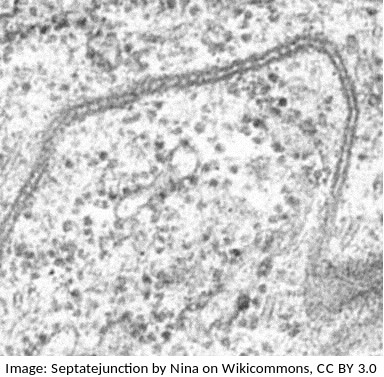 The photograph is from an electron microscope image of a membranes.
The photograph is from an electron microscope image of a membranes.
Parallel dark lines are clearly seen.
In electron micrography, heavy metal stains are often used to enhance contrast. DNA and Proteins often show as dark areas because these molecules can attach to the stain.
Which of the following interpretations is most similar to the proposal of the Daveson-Danielli model of membranes?
Students are expected to know how to use evidence from electron microscopy to support an idea about membranes. One illustration of this is the proposal of the Davson-Danielli model.
Further evidence lead to the falsification of the Davson-Danielli model and the proposal of the fluid mozaic model.
The electron microscope image below shows three organelles found in an animal cell.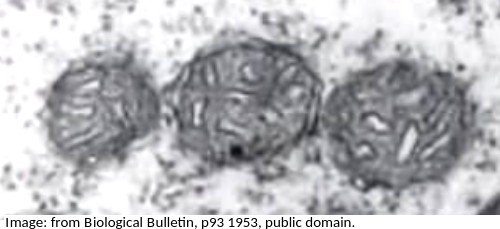
What is the name of the organelles?
Know how to idenfity the organelles in eukaryotes and draw their compartmentalised structure.
A mitochondrion (pleural = mitochondria) has an outer membrane and inner membrane folded into long thing 'flaps' called cristae.
The electron microscope image below shows an organelle found in both animal and plant cells.
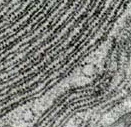
What is the name of the organelle?
Know how to idenfity the organelles in eukaryotes and draw their compartmentalised structure.
The rER has parallel membranes covered in dots, which are ribosomes, used for making proteins, for secretion from the cell.
What are the structures labelled X and Y likely to be in this electron microscope image?
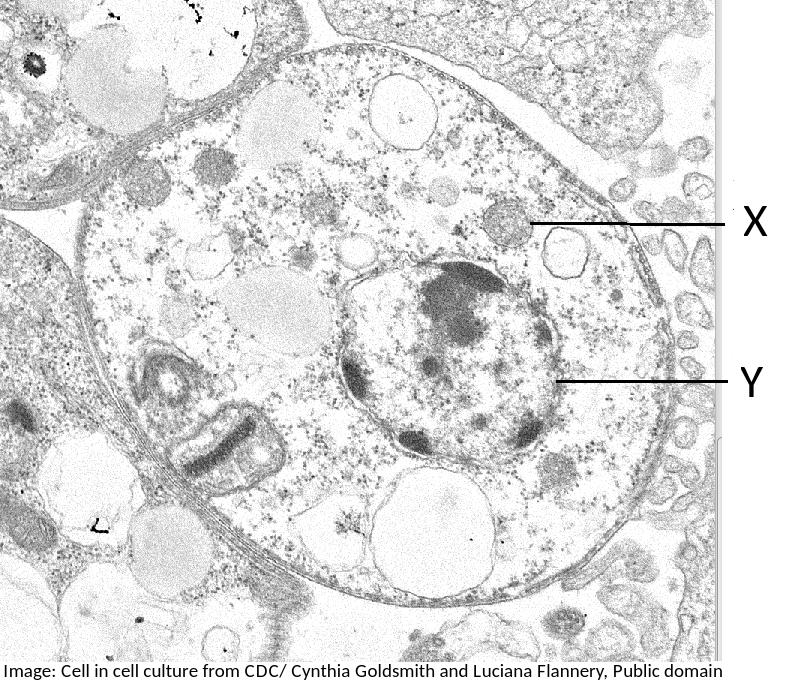
Students are expected to be able to identify organelles from microscope images of cells. The nucleus is distinctive because it is about 10µm in size, and it has black dots in it, chromatin, and sometimes one or more dark patches within the nuclear membrane. It also has a double membrane, not often easily visible.
Cell theory covers most, but not all cases.
Which one of these statements is an exception?
Exceptions to cell theory are : multinucleated striated muscle the giant single celled Acetabularia algae?
Also, organisms consisting of only one cell carry out all functions of life in that cell. e.g. Paramecium, Chlorella.
The image below shows erythrocytes and leucocytes.l.
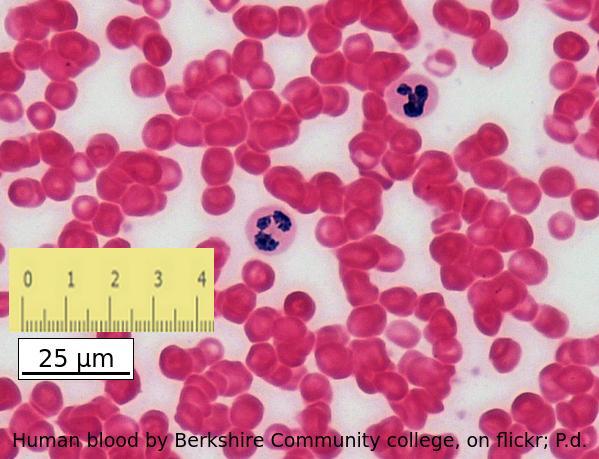
Using the scale bar and the ruler placed on the image, estimate the magnification of the image.
Which answer is the best estimate
Calculate the magnification of an electron microscope image from a scale bar?
Convert the ruler measurement to the same units written on the scale bar, in this case 25mm is 25000µm
then divide the ruler measurement 25000 by the number on the scalebar, 25.
Which of the following are methods by which molecules can move across membranes?
- Simple diffusion
- Facilitated diffusion
- Cytokinesis
- Active transport
There are actually four types of membrane transport which are required in DP Biology, Simple diffusion, facilitated diffusion, osmosis and active transport.
Human red blood cells are circular and 0.6 μm in diameter. A photograph of a red blood cell is shown as an illustration in a book with a diameter of 1.2mm. What is the magnification of the diagram?
Comment: Convert 1.2 mm into μm by multiplying x 1000 = 1200 μm (so that both units are the same). Then you can see that 0.6 x 2000 = 1200. Or use the formula Magnification = Image size/true size. If the photograph is larger than the cell, the magnification could not be 0.5x which would make it smaller. Eliminate obviously incorrect answers.
Which organelle in a eukarytotic animal cell synthesises proteins for exocytosis?

The RER synthesises proteins for exocytosis.
Which organelle is visible in an electron microscope but not in a light microscope?

The ribosome is too small to be seen in the electron microscope, the other organelles were seen in the light microscope before the electron microscope was invented.
Which organelles are found in large numbers in secretory cells in animals? I Vesicles II Golgi Body III Mitochondria IV Rough endoplasmic reticulum.

Secretory cells synthesise proteins for exocytosis so have large numbers of mitochondria to supply energy, RER to synthesise the proteins for packaging into vesicles by the Golgi Body.
The image is of a channel protein. What is the function of a membrane channel protein?

Channel proteins are used for facilitated diffusion down the concentration gradient.
Which organelles in a plant cell are believed to have originated as free-living prokaryotic cells?

Both the mitochondria and the chloroplast in plant cells are thought to have been free-living prokaryotes which evolved in a symbiotic relationship with a eukaryotic cell.
A mitotic index taken from this microphotograph only would not be regarded as valid. How can a valid count be made?

There are twenty complete cells in this microphotograph (with complete nuclear material). Estimate the number of complete cells in prophase of mitosis.

There are 3 complete cells in prophase (chromosomes visible in a nucleus..
Refresh this page to try a new set of 20 multiple choice questions. The questions will be different next time you visit. Great revision.

 Twitter
Twitter  Facebook
Facebook  LinkedIn
LinkedIn